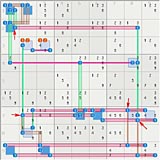Hi to all.
I thought it might be interesting to add a set logic solution to the others for comparision. I have posted brief set logic descriptions along with references to diagrams and images with more detail. Eliminations are of the form:
Rank N(n sets+ l linksets), [ cover sets ]=[ linksets ] reason for elimination => result
Sets: 9r3 is the set of 9s in row 3, and 4n5 is the set of candidates in cell r4c5. A finned X-wing in the rows would be: rank 1 (2,3) [5r25] = [5c25 5b1]
5c2*5b1 => r1c2<>5, where the * indicates overlap sets. For more on sets and notation, see this
short reference or a full description at
sudokuone.com. I apologize for the troublesome notation, which is partly due to differences between 1st and 2nd order logic. The referenced diagrams should help.
ttt wrote:
Step 4) A complex step : (9)r3c3=(9-4)r3c2=(hp34)r78c2-(4=hp19)r9c13-(19)r9c89=(hp19)r7c89-(19=hp34)r7c26-(134=5)r7c5-[(5)r4c5 & )r7c8] = {(6)r1c1=(6)r2c1-(6)r2c8=(6-5)r4c8=(5)r4c1}-(5)r1c1=(ht126)r12c1/r1c2
=> r3c23<>12 .......how to present it as Diagram, too complex...
Ttt, below is a set diagram (click to enlarge) for elimination 4 where the solid bars are strong sets. Your solution is very elagant and this eliminationmakes a good comparison with set logic. It uses 33 sets, 14 strong sets, and has a rank of 5 because it needs 5 extra linksets to cover the sets. A finned fish has a rank of 1. Several triplets make up for the extra linksets (red arrows).
 3D view
3D viewI also tried drawing Steve's move 1 (another nice move)
here, as drawn by ttt.
This solution has two complex steps (7, 11) each with 34 sets.
(1) Rank 1(5,6), [9r3 2r7 6c3 16n2] = [129c2 78n3 9c3]
9c2*(78n3) => r78c3<>9
Short ALS chain(2) Rank 1(4,5), [9r3 2r7 16n2] = [129c2 2c3 3n3]
2c2*3n3 => r3c3<>2
Short ALS chain(3) Rank 1(6,7), [12r5 46r6 59c4] = [5n46 6n479 8n4 2b6]
2b6*5n46 => r6c7<>2, r6c9<>2
3D kraken with ALS chain(4) Rank 1(5,6), [6r36 78n7 4b6] = [6c4 456c7 6n9 6b3]
6c7*6b3 => r2c7<>6
Finned X-wing + ALS chain(5) Rank 1(8,7), [46r6 59c4 78n7 5n8] = [59r5 456c7 6n49 8n4]
5c7*5r5 => r5c7<>5
Rank 1 multiloops(6) Rank 2(12,14), [8r1 46r6 6c1 5c3 3c7 356c8 23n4 6b2] = [6r1 36r2 5r6 3r9 168c4 1n3 4n8 6n79 7n8 5b6]
5r6*6n7*5b6 => r6c7<>5,
(T)5c8*7c8 => r7c8<>5
Rank 1 multiloops(7) Rank 2(16,18), [13568r1 6r2 1r6 5c3 9n1 1236n4 1b3 9b4 6b5] = [1r3 59r6 169c1 1c2 368c4 6c6 1n139 2n8 6n3 13b2],
(T)1r3*1b2 => r3c5<>1
Complex structure(8) Rank 0(1,1), [1c5] = [1b8]
1b8 => r7c6<>1, r8c4<>1, r8c6<>1
Locked candidates(9) Rank 2(8,10), [5r7 4c256 7n89 8n7 1b8] = [4r3 149r7 4r8 78n5 4b2 56b9]
(TT)4r7 => r7c3<>4, r7c7<>4,
(TT)8n5 => r8c5<>3, r8c5<>5
Intertwined ALSs and chain make rank 0 sets(10) Rank 2(8,10), [2r6 19c1 136n2 3n5 2b7], [4r3 129c2 2c3 2c5 69n1 1b1 9b4]
(TT)2c3 => r1c3<>2, r2c3<>2
Intertwined ALSs make rank 0 sets(11) Rank 4(15,19) [4r269 6r36 5c48 7c9 3n5 5n7 7n7 8n357 6b6] = [2r3 57r5 156r8 4c3 6c4 4c5 2456c7 6c9 4n8 6n49 9n9 4b2]
(TTT)2r3*2c7 => r3c7<>2
Complex structure(12) Rank 4(10,14) [5r147 6c1 8c3 14c5 6c8 3n7 4b1] = [6r2 48r3 6r7 5c15 6c7 1n13 2n3 4n8 7n57 8n5]
(TT)6r7*6c7*7n7 => r7c7<>6 =>
5r7c7 => r7c57<>5 =>
5r8c5 => r56c4<>5 r8c4<>39 =>
5r5c8 => r4c8<>5 r5c8<>9
Multiloop with 3-way chain overlap,
(13) Rank 0(2,2), [39r8] = [8n26]
8n26 => r8c2<>1, r8c2<>4 8c6<>4
Hidden pair,
(14) Rank 1(2,3), [4c2 4b8] = [4r37 4c5]
4r3*4c5 => r3c5<>4 => 4r2c6 => r2c3<>4 r2c6<>1236 r7c6<>4 =>
2r3c5 => r3c29<>2 r46c5<>2 r1c6<>2
Box ended chain,
(15) Rank 1(4,5), [2r7 6c3 4c5 8n7], [4r7 46r8 7n23]
4r7*7n2 => r7c2<>4 =>
4r3c2 => r3c2<>19, r3c3<>4 =>
9r3c3 => r3c3<>18 r79c3<>9, r5c7<>2 =>
8r3c7 => r3c7<>6, r3c4<>8=>
7r5c7 => r5c9<>7, r9c7<>7 => 7r9c9 => r9c9<>1349
Simple chain,
(16) Rank 2(8,10), [1r5 2c167 5c1 6c6 9c4 9b4] = [2r25 6r1 9r6 146n1 5n4 45n6]
(T)6r1*1n1 => r1c1<>6 =>
6r2c1 => r2c1<>12, r2c48<>6 =>
2r2c7, r2c7<>38, r1c9<>2
AALS like multiloop + converging chains(17) Rank 1(8,9), [6r3 19r5 26c6 4n8 36b3] = [6r4 3c8 1n9 3n9 4n6 5n46 6b2 9b6]
6r3*6b3 =>
6r3c9, r1c9<>6, r3c4<>6
Discontinuous Nice Multi-loop with ALS(singles to the end)


